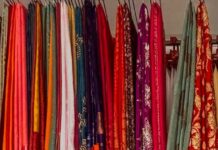By Hala Nasar
With a sharp needle close to Tom Hanks’ lower back, Isabela Tavares’ face morphed from one of utter focus and concentration to sheer shock as her mentor said to the Oscar-winning actor, “Tom, Ms. Isabela was asking if she could take a picture with you. And you can’t say no because she has a very sharp object near a sensitive area.”
Costume design was never Tavares’ first choice. She stumbled upon it in her home country, Brazil, when she was working on a children’s play, which reminded her of her childhood.
Growing up, Tavares had her clothes made by her childhood seamstress, and eventually, she began designing clothes for herself and her friends. A degree in fashion textiles followed. It was clear to her that drawing was her way of communicating her ideas to the world and those around her.
“I thought the lesser of all evils was to study fashion,” she said. However, soon enough she found the fashion world to be “incredibly superficial” and not what she wanted to do.
““Costume in itself is a narrative. It has a beginning and an end. It has lived a life, and there is a story that it carries. That story is the whole story.”
In her senior year at university, she went to the United States on an exchange program to study fashion merchandising. That’s when she met Jackie Mullins. The professor with short hair and 50s glasses became Tavares’ mentor and handed her front-seat tickets to the Theatre life. The first project she worked on was cataloging bathing suits from the 1920s to the 1960s, which was the start of a journey of discovering her passion for costume design.
“I still get goosebumps when I remember going to the storage room, picking up the boxes that haven’t been opened in decades, thinking about the specifics of these items and who wore them and creating a narrative behind these items,” said Tavares.
She realized that she was in her happy place when she took a history of costume course in which she was introduced to everything she wanted to do in life. From reading plays to creating costumes for those characters, Tavares felt like she belonged.
Her favorite part about creating a costume is that it keeps her curious. There is always something new to learn, and it’s always about people. It’s an art about humans for humans.
When asked about making a costume come to life, Tavares simply said that it’s about connecting people beyond words. The human connection lies in subtle “silent communication through colors, shape, shadows and highlights.”

Being a visual storyteller, Tavares has a gallery of fabrics, textures, colors and designs circulating in her head at all times, or “organized chaos,” as she likes to describe it.
In theatre, this organized chaos translates to the stage. Tavares said that theatre allows for imperfection, which reflects what real life is like. Unlike films, theatre is linear. The cast and crew all start and end at the same place. This process highlights how ritualistic theatre can be compared to film.
One of the rituals that Tavares particularly enjoys when she begins designing costumes for a show is opening the script and seeing the description of the characters and the playwright.
“Being forced to let go [on opening night] is incredibly powerful. It’s very natural because it flows with the very natural circle of life,” she said.
“These elements of theatre spice up my mind with ideas,” she said.
To understand how costume differs from everyday fashion, one must focus on how the character’s clothing reflects a period, an era, or a personality. While fashion can be a pathway to a story, costume is meant to be a reflection.
According to Tavares, designing a costume isn’t an easy venture. There are many moving pieces during the process of creating a costume for a show. Tavares notes a few things to consider, such as the individual narrative of the character and the broader narrative of the entire play. Figuring out how to put those together to create a coherent image can be quite a challenge.
“It’s a logistical nightmare is what it is,” she laughed.
Recalling her favorite costume, Tavares described a run-down robe she found in storage on the set of “Elephant Man,” which she altered into a “beautiful Victorian dress that had so much texture and movement” with intricate vintage white lace.
Tavares describes finishing a costume as cathartic. Her job starts the moment she flips the script page open and ends when the actor is on stage. This is when her work becomes the audience’s and not hers.
As a professor, she finds sharing what she loves doing with like-minded people is what drives her. Seeing students who are interested in costume design discover themselves and their style is something she always looks forward to.
To her, knowledge is empowering to have, to share and to pass on; she finds that being a professor at AUS gives her that platform to connect with her students, learn from them and exchange ideas.
While her first Broadway experience was spent fitting a suit for Tom Hanks, Isabela Tavares spent her life after college going through the motions of choosing a career path, finding a place to belong and getting to know herself. Today, art and students find refuge in her office.
“I now know that I should be exactly where I am.”


















